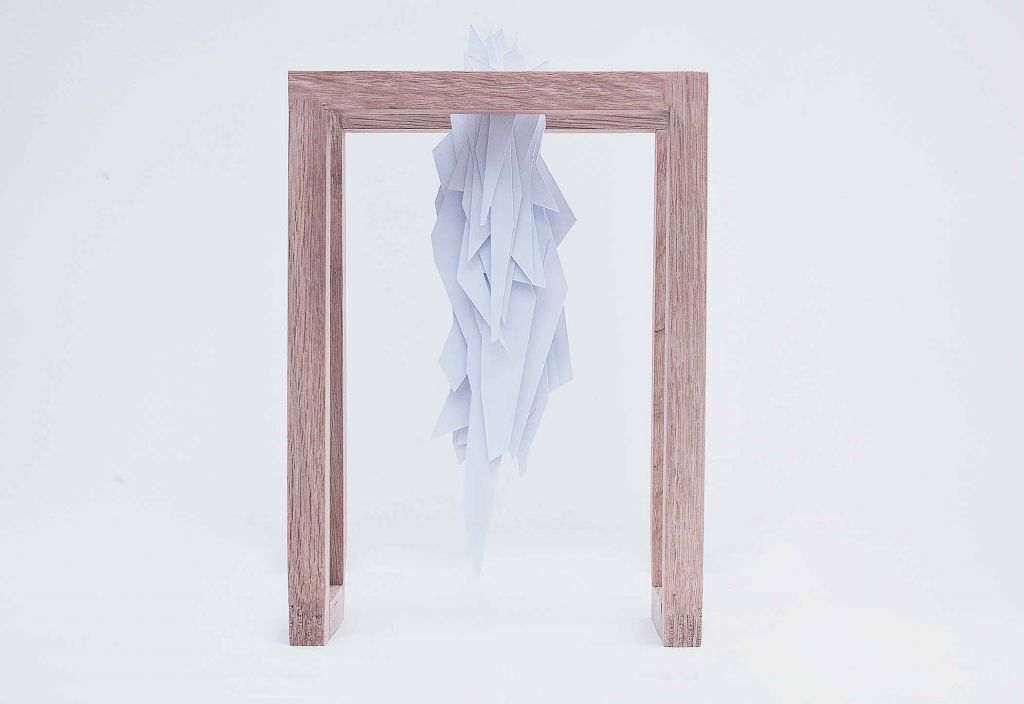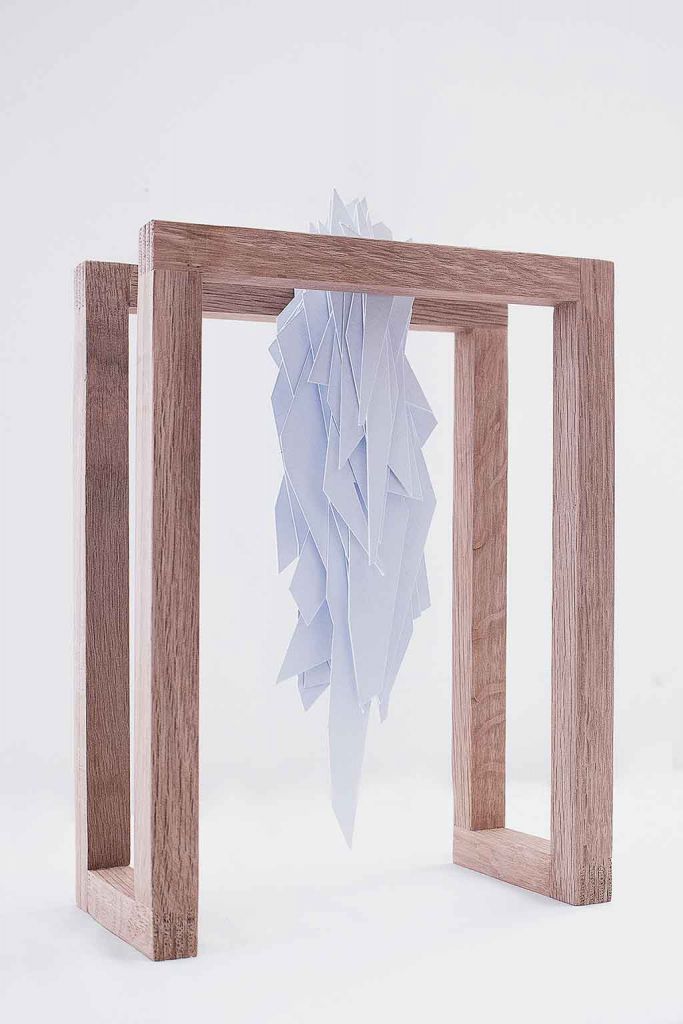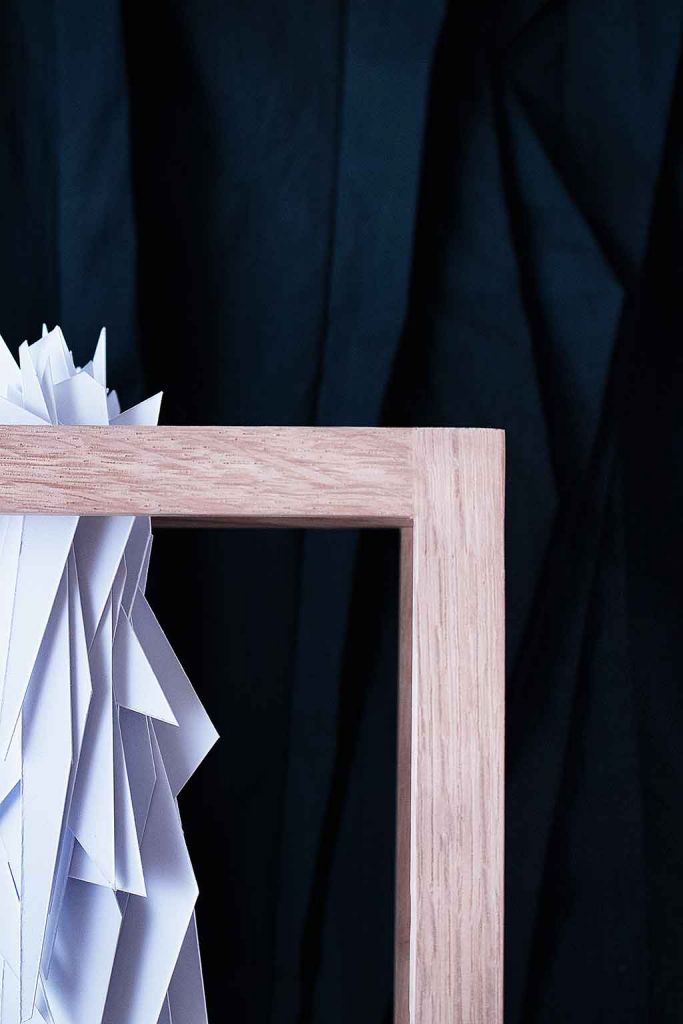Text by Maren Häußermann

For Mae Maze London, the aim is to be more than a fashion brand. And one way to do this is by collaborating with other experts in other disciplines, connecting, and sharing ideas, opinions, and skills. In her first collaboration, the fashion designer joined forces with visual artist Daniel Solomons.
Inspired by Mae Maze’s clean lines and simple structures, he developed his concept for an art piece that focuses on the body’s architecture. He deconstructed it into blueprints, measuring and tracing the outlines of both male and female models’ arms, shoulders, hands and the silhouette. The outcome is 36 pieces of two-dimensional heavy paper figures – 18 derived from the female and 18 from the male body – pinned side by side into a wooden frame.
While the artist was working on this project, the partner’s design studio was merely two miles away. But with London in lockdown, the collaboration got extraordinarily interesting. Mae Maze looked at the photos Solomons sent, at what seemed like layers of skin he recreated on paper. This was the template for designing a new piece of clothing. I started to see that I had to use similar shapes to the ones he was producing. This way, we would go from analysing and simplifying a human body shape to a garment covering a body with its figure. Complex but simple at the same time. Mae Maze told CLOT.
The minimalist unisex brand took up the challenge and created a black shirt on the left side of the breast, adding various layers of fabric in the form of Solomons pieces. Therefore, the design got a three-dimensional and asymmetrical shape and consequently seemed to be citing the original body.
The dialogue between fashion and art is the driving force of this collaboration. For Mae Maze, fashion is not just clothing. It is about its craft and expression. The designer herself shares her skills with other professionals who want to start their fashion brand because, for her, the exchange of knowledge is crucial for creation. It is the only way to develop their work further and find solutions to problems that might be in the way of creativity.
Like so many other branches, the fashion industry, too, is in the middle of reinventing itself. Experimenting with new materials, and technologies, and finding a way to express the products in relation to the modern lifestyle requires a lot of work. We only start to see the possibilities by looking outside their field of expertise and exchanging ideas with other people. This is how Mae Maze got the idea for the collaboration.



They must be involved in the creation process to make people understand something.” This applies to Mae Maze herself, who is working at the forefront of making fashion more sustainable and the society who needs to buy it because change is only possible if people understand how their clothes are made. “I think that a good way to explain is to practically show others, not just talk, but involve them in its making, its creative process. Mae Maze continued.
Behind Mae Maze, there is the aim of slowly creating an ever-growing community of people to impart our skills and philosophy. People call her idealistic, but Mae Maze’s spirit is inspired by Coco Chanel, who did it her way. When Chanel started, she would not spend money on promotion or look to the business side. Her priority was the body. Clothes were there to support their beauty.
With the collaborations, Mae Maze, too, found another way to promote her products. And with this first teaming up with Daniel Solomons, the body, too, got its attention. There is an ancient relationship between the body and architecture. Fashion designers and architects rely on structures and proportions. They create pieces for us to “inhabit”, from different sensitivities and experiences to make us feel better and seek a perfect balance between creativity and functionality. The visual artist explains that both use the body as a model to energise the experience of a world to which we inseparably belong.
Daniel Solomons gets his inspiration from the urban environment and its effect on people. The social dimension of architecture and how it conditions human interaction and its organisation is an important concern in my formal research”, Solomons says. And like this, he approached Mae Maze’s work, too. He was interested in the role of the body as a structural and functional perception in her designs.
She uses her mathematical formula and cuts the silhouette without following the body’s shape. It reminded me of the proportionality system that Le Corbusier developed: The Modulator. A system of measurements could rule over lengths, surfaces and all volumes while maintaining the human scale thanks to the miracle of numbers. Without a doubt, the greatest event that modernity left with the use of the body in architecture. This new anthropometric reasoning served him as a starting point.
The artist with Spanish and English roots has yet another connection when it comes to his body. At the age of 21, he had a stroke and was consequently suffering from amnesia. He had to relearn how to speak, walk, read and write. So, for him, the artistic representation resulting from his identity’s continuous reconstruction expresses who he is and can be.
Solomons use multiple connections between plastic arts, architecture and literature, theory and practice, drawing and colour, and forms and content for his work and collaboration with Mae Maze. He crossed the bridge to fashion, too. It is fascinating to see how your piece forms the cornerstone of another creation, crosses borders to another discipline, and, in turn, becomes another different piece with another purpose.






